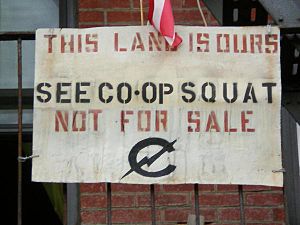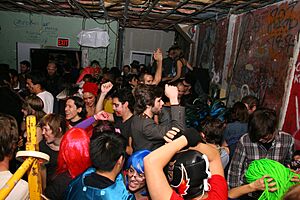C-Squat facts for kids
Quick facts for kids C-Squat |
|
|---|---|

Squatters' notice at C-Squat
|
|
| General information | |
| Address | 155 Avenue C |
| Town or city | Manhattan, New York |
| Country | United States |
| Coordinates | 40°43′33″N 73°58′40″W / 40.725708°N 73.977791°W |
| Completed | 1872 |
| Known for | Former squat house |
C-Squat is a special building in New York City. It's located at 155 Avenue C in the Alphabet City area of Manhattan. For many years, it was a "squat house," meaning people lived there without officially owning it. It became a home for musicians, artists, and people working for social change.
After a fire, the city took ownership of the building in 1978. People started living there without permission in 1989. The building was fixed up in 2002. Since then, the people living there have legally owned it. Today, the ground floor of C-Squat is home to the Museum of Reclaimed Urban Space.
Contents
History of C-Squat
Early Years and City Ownership
C-Squat was built in 1872. Over the years, it was used for many different businesses. It was a pickle shop, a cigar factory, and even a place for political meetings.
In 1978, a fire badly damaged the building. The city of New York then took control of it. Some people, mostly from Latino and Black communities, stayed in the building. They lived there without permission and even ran a secret club. Six years later, they were asked to leave. The building was empty until 1989. That's when the people who live there now moved in. The building has been occupied ever since.
How Squats Started in New York
Journalist Robert Neuwirth explained why many buildings in New York became squats. In the 1970s, many landlords left their old buildings empty. These buildings became run-down. By the 1980s, people started moving into these empty buildings. They lived there without permission, especially in areas like Alphabet City.
These residents had to fight to stay. The city tried to remove hundreds of them. Sometimes, there were big operations to clear the buildings. In the end, 12 squatter buildings, including C-Squat, managed to stay. They survived the city's efforts to remove them.
Becoming Legal Homes
After many discussions, New York City gave temporary ownership of C-Squat and 11 other buildings to a group called the Urban Homesteading Assistance Board (UHAB) in 2002. This group helps people create legal housing. UHAB helped to fix up C-Squat and turn it into a cooperative housing building. This means the residents now own and manage the building together.
UHAB worked with the residents, a bank, and the city's housing department. They got loans to help repair the buildings. The goal was to make sure the buildings met all safety and building rules. They also helped set up special co-op housing groups. This process transferred ownership of the buildings to the people living in them.
Because of this, C-Squat is no longer a "squat." It's a legally owned building. The former residents bought it from the city in 2002 for a very small amount of money. This deal was arranged by the Urban Homesteading Assistance Board.
Fun and Community at C-Squat
For many years, C-Squat had a special half-pipe in its basement. This was built from recycled materials for skaters. The building also often hosted punk rock music shows.
C-Squat has been a home for many artists and people working for social change. Robert Neuwirth wrote about his visit to C-Squat. He said that walking up the stairs was like walking through a living graffiti artwork. The hallways looked like old subway cars. Instead of just names, the walls had messages about change and funny ideas about official rules.
Restoring the Building
When people first moved into C-Squat, the building was in bad shape. Some of the main support beams were rotten and had to be replaced. The residents found used beams and bought them as cheaply as possible. The people living there did all the repair work themselves. They fixed up the building and changed it as they worked.
This "do-it-yourself" (DIY) repair was a huge job. Neuwirth noted that the beams were so rotten that the building had sunk almost a foot in the middle. The residents replaced the beams one by one. They even got old but still usable beams from a nearby construction site.
As part of the agreement in 2002, UHAB helped get a loan for necessary repairs. These repairs were needed to make the building meet city safety rules. The residents did as much of the construction work as they could to save money. Once the work was finished, the residents officially became the owners of the building. They now own it as a limited equity housing cooperative.
Museum of Reclaimed Urban Space
The Museum of Reclaimed Urban Space (MoRUS) is located on the ground floor of C-Squat. It's at 155 Avenue C. This museum keeps alive the history of the Lower East Side's squats and community gardens.
The museum offers tours of the neighborhood. These tours show how local people worked to clean up empty lots and fix abandoned buildings. They turned these spaces into places for the community to use. MoRUS also collects and shares information about how people have worked to create community spaces in cities. Its exhibits show photos, posters, and other items that tell these stories. They teach people about the importance of taking back urban spaces.
Community activists in the East Village started planning the museum in May 2011. It opened with public tours in October 2012.
The museum's storefront shows many items. These include photographs, posters, and old newspapers. They show how local residents cleaned up empty lots and buildings. They also show how these spaces became important places for community organizing. The museum offers three walking tours. These tours take visitors to famous community gardens and former squats in the East Village. They explain the interesting and sometimes difficult histories of these places. The tour guides are often activists, residents, or journalists who were directly involved in the neighborhood's history.
After it opened, The New York Times wrote about MoRUS. They said, "MoRUS Squats on Avenue C." Even though the museum is not officially part of C-Squat, it operates independently. The process of making C-Squat legal brought up new questions for the residents. They had to decide how to balance the building's needs with the needs of the wider community. In the end, most residents agreed that the museum was a good idea. It was a tenant that would share the ideas and spirit that were important to the building and the East Village itself.
See also
 In Spanish: C-Squat para niños
In Spanish: C-Squat para niños
- ABC No Rio
- Bullet Space


